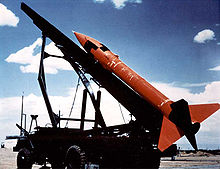MGR-1 Honest John
The MGR-1 Honest John rocket was the first nuclear-capable surface-to-surface missile in the United States arsenal. Designated Artillery Rocket XM31, the first such rocket was tested 29 June 1951 and the first production rounds were delivered in January 1953. The designator was changed to M31 in September 1953. The first Army units received their rockets by year's end and Honest John battalions were deployed in Europe in early 1954. Alternatively, the rocket was designed to be capable of carrying an ordinary high-explosive warhead weighing 680 kilograms (1,500 lb), even though that was not the primary purpose for which it was originally envisioned.
Developed at Redstone Arsenal, Alabama, Honest John was a large but simple fin-stabilized, unguided artillery rocket weighing 2,640 kilograms (5,820 lb) in its initial M-31 nuclear-armed version. Mounted on the back of a truck, HJ was aimed in much the same way as a cannon and then fired up an elevated ramp, igniting four small spin rockets as it cleared the end of the ramp. The M-31 had a range of 24.8 kilometres (15.4 mi) with a 20 kiloton nuclear warhead and was also capable of carrying a 680 kilograms (1,500 lb) conventional warhead. Early tests exhibited more scatter on target than was acceptable when HJ was conventionally armed. Development of an upgraded Honest John, M-50, was undertaken to improve accuracy and extend range. The size of the fins was greatly reduced to eliminate “weathercocking” (the tendency of crosswinds to turn a rocket to face into the wind). Increased spin was applied to restore the positive stability margin that was lost when fin size was reduced. The improved M-50, with the smaller fins and more “rifling”, had a maximum range of 30+ miles with a scatter on target of only 230 metres (250 yd), demonstrating an accuracy approaching that of tube artillery. Honest John was manufactured by the Douglas Airplane Company of Santa Monica, California.
The M31 consisted of a truck-mounted, unguided, solid-fueled rocket transported in three separate parts. Before launch they were assembled in the field, mounted on an M289 launcher and aimed and fired in about 5 minutes. The rocket was originally outfitted with a W7 variable yield nuclear warhead with a yield of up to 20 kilotons of TNT (84 TJ) and later a W31 warhead with three variants was deployed with yields of 2, 10 or 30 kt (8.4, 41.8 or 125.5 TJ) in 1959. There was a W31 variant of 20 kt (84 TJ) used in the Nike Hercules antiaircraft system exclusively. M-31 had a range between 5.5 and 24.8 km (3.4 and 15.4 mi).
...
Wikipedia

